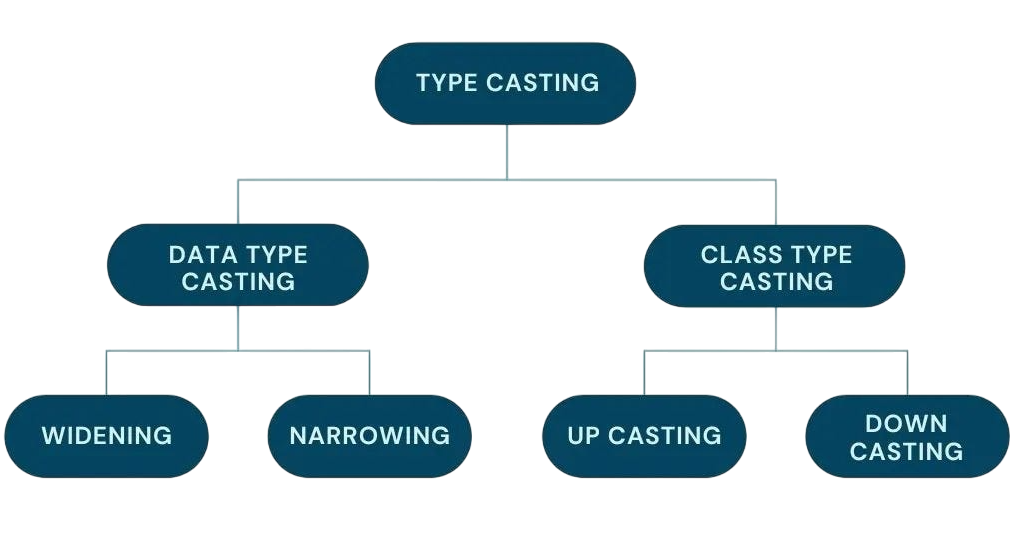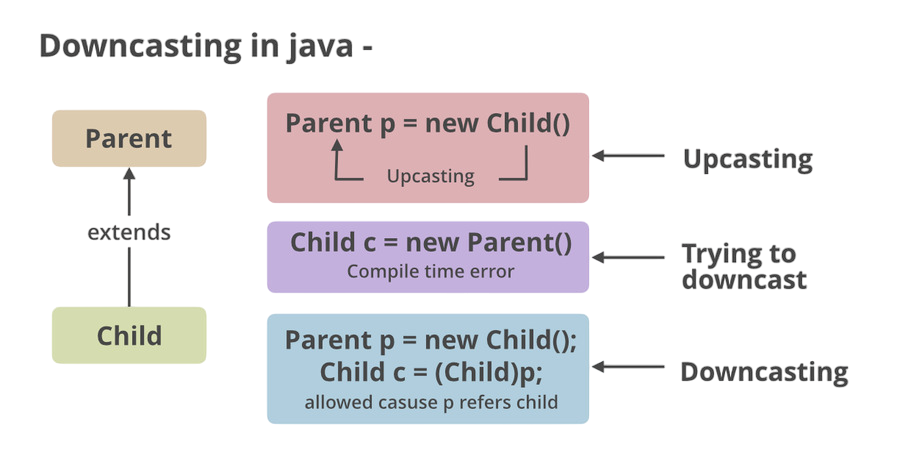
- Introduction to Type Casting in Python
- Implicit vs Explicit Casting
- int(), float(), str(), bool() Functions
- Casting Complex Data Types
- Casting in Expressions
- Common Conversion Scenarios
- Errors and Exceptions
- Type Checking Before Casting
- Use Cases in Input Handling
- Chaining Casts
- Best Practices
- Summary
Introduction to Type Casting in Python
Type Casting in Python, also known as type conversion, is the process of converting the value of one data type to another in Python. It plays a crucial role in ensuring data compatibility and proper execution of operations.

For example, converting a string representation of a number to an integer allows it to participate in mathematical calculations. To apply such conversions effectively across diverse data structures, exploring Full Stack With Python Course reveals how full-stack Python training equips developers to handle type transformations, manage exceptions, and build resilient applications that rely on clean, predictable data flow. Python supports both automatic (implicit) and manual (explicit) type conversion. Python is a dynamically typed language, meaning that you don’t need to declare a variable’s data type explicitly. However, there are situations where you’ll need to convert data types to maintain consistency in your code or to avoid type-related errors.
To Earn Your Full Stack With Python Course Certification, Gain Insights From Leading Web Developer Experts And Advance Your Career With ACTE’s Full Stack With Python Course Today!
Implicit vs Explicit Casting
Python performs implicit type casting when it automatically converts a value from one type to another without user intervention. This happens when operands of mixed types are used in expressions and Python safely converts the data to a common type. For instance, when you add an integer to a float, Python converts the integer to a float to perform the operation. This behavior ensures the result is accurate and doesn’t result in data loss. To understand how type safety and conversion principles apply in Java-based frameworks, exploring Spring Boot vs Spring MVC reveals how each framework handles configuration, dependency injection, and runtime behavior helping developers choose the right approach for scalable enterprise applications.
- x = 10
- y = 2.5
- z = x + y # x is implicitly converted to float
- print(z) # 12.5
Explicit casting, also known as type coercion, requires the programmer to convert data types using built-in functions like int(), float(), str(), and bool(). This approach gives developers full control over the conversion process, ensuring that the data is transformed appropriately before further operations.
int(), float(), str(), bool() Functions
These built-in functions are the primary tools used for type casting in Python: int(), float(), str(), and bool(). They help convert data types explicitly, ensuring compatibility and preventing runtime errors. To understand how mastering such foundational skills translates into career growth, exploring IT Engineer Salary reveals how technical proficiency in languages like Python contributes to higher earning potential across roles in software development, data engineering, and system architecture.
- int(x): converts x to an integer. It truncates decimal parts and expects the input to be a number or a numeric string.
- float(x): converts x to a floating-point number. Useful when precision is required.
- str(x): converts x to a string. Ideal for display purposes and concatenation.
- bool(x): converts x to a Boolean value. Non-zero values, non-empty strings or collections return True, otherwise False.
Examples:
- print(int(“10”)) # 10
- print(float(“5.5”)) # 5.5
- print(str(25)) # ’25’
- print(bool(0)) # False
- print(bool(“hello”)) # True
Each function has its own set of conversion rules and limitations. Misusing them can lead to ValueError or TypeError exceptions.
Would You Like to Know More About Full Stack With Python Course? Sign Up For Our Full Stack With Python Course Now!
Casting Complex Data Types
Python also allows conversion between complex data structures like lists, tuples, sets, and dictionaries. These transformations are useful for organizing data, optimizing performance, and enabling flexible operations. To extend functionality beyond built-in features, exploring What is pip reveals how Python’s package manager simplifies the installation of external libraries empowering developers to integrate advanced tools and frameworks into their projects with just a single command.
- list(): converts a sequence (string, tuple) into a list.
- tuple(): converts a sequence to a tuple.
- set(): converts to a set (automatically removes duplicates).
- dict(): constructs a dictionary from an iterable of key-value pairs.
Examples:
- print(list(“abc”)) # [‘a’, ‘b’, ‘c’]
- print(tuple([1, 2, 3])) # (1, 2, 3)
- print(set([1, 2, 2, 3])) # {1, 2, 3}
- print(dict([(“a”, 1), (“b”, 2)])) # {‘a’: 1, ‘b’: 2}
These conversions are helpful in scenarios involving data preprocessing or when specific structures are needed for function inputs.
Casting in Expressions
When you work with mixed data types in Python, it’s important to know how implicit and explicit casting in expressions functions. Implicit conversion happens automatically and prevents any loss of precision during arithmetic operations.

For example, if you add an integer and a float, like in the case of a = 5 and b = 2.0, Python converts the integer to a float, so the result is also a float. Checking the type of the result confirms this behavior. To understand how such implicit conversions work alongside structured transformations, exploring Full Stack With Python Course reveals how full-stack Python training equips developers to manage type coercion, handle mixed data inputs, and build resilient applications that adapt to dynamic runtime conditions. On the other hand, explicit casting is necessary in situations like string concatenation. For instance, if you want to include a number in a message, you must convert the number to a string using str(age) before combining it with other text.
Are You Interested in Learning More About Full Stack With Python Course? Sign Up For Our Full Stack With Python Course Today!
Common Conversion Scenarios
In programming, handling different data types effectively is crucial for building reliable applications. One common task is converting user input from strings to numeric values when doing calculations. This lets developers use mathematical functions and operations without errors. Making sure that integers are converted to strings can improve output formatting, which makes results easier to read for users. Another important aspect is evaluating conditions using boolean values. By converting variables to booleans, developers can create logical flows that enable or disable certain functions based on specific criteria. To apply these logical flows in real-world applications, exploring Node.js Installation on Windows and Ubuntu reveals how setting up a runtime environment enables developers to build scalable, event-driven applications where conditional logic drives user interactions and backend responses. These basic skills, converting inputs, formatting outputs, and using boolean logic, are important in everyday coding and help create cleaner, more efficient code. Mastering these practices not only helps in solving problems but also improves overall code quality.
Errors and Exceptions
Improper use of type casting functions can lead to exceptions: converting incompatible types, overlooking null values, or misusing built-in functions like int(), float(), and str() can cause runtime errors. To avoid such pitfalls and build resilient applications, exploring Skills Needed for Full Stack Developers reveals how mastering type safety, error handling, and data validation is essential for managing both frontend logic and backend operations effectively.
- int(“abc”): raises ValueError because “abc” isn’t a valid integer.
- float(“12.3.4”): also raises ValueError due to multiple decimal points.
Handling these errors with try-except blocks improves reliability:
- try:
- num = int(“abc”)
- except ValueError:
- print(“Invalid input”)
Always validate or sanitize inputs before performing conversions.
Preparing for Full Stack With Python Job Interviews? Have a Look at Our Blog on Full Stack With Python Interview Questions and Answers To Ace Your Interview!
Type Checking Before Casting
To ensure safe casting, check the data type using type() or isinstance(): this helps prevent runtime errors and ensures that operations are performed on compatible data. To extend this principle to frontend data handling, exploring What is Axios in React reveals how Axios simplifies HTTP requests, enabling type-safe communication between React components and backend APIs making data exchange more reliable and maintainable.
- x = “123”
- if isinstance(x, str):
- x = int(x)
This is particularly useful when handling heterogeneous data sources or optional inputs.
Use Cases in Input Handling
User inputs from input() are received as strings by default. Type casting is necessary to convert these into usable formats: integers for calculations, floats for precision, or booleans for condition checks. To see how input handling scales in full-stack environments, exploring What is MEAN Stack reveals how MongoDB, Express.js, Angular, and Node.js work together to process, validate, and store user data across dynamic web applications.
- height = float(input(“Enter your height in meters: “))
- weight = float(input(“Enter weight in kg: “))
- height = float(input(“Enter height in meters: “))
- BMI = weight / (height ** 2)
- print(“Your BMI is”, round(BMI, 2))
This allows for arithmetic operations like calculating BMI.
Chaining Casts
In certain chaining casts, multiple type conversions are necessary. For instance, if you have a float as a string and need the integer part: first convert the string to a float, then cast it to an integer. To apply such logic in backend environments, exploring How to Install Node.JS on Ubuntu reveals how setting up Node.js enables developers to build scalable applications where type-safe operations and data parsing are critical for reliable server-side execution.
- x = float(“45.6”)
- y = int(str(x).split(“.”)[0])
- print(y) # 45
This is especially useful in data extraction, cleaning, and transformation tasks.
Best Practices
- Use Explicit Casting: Avoid relying on implicit conversions unless the outcome is guaranteed.
- Check Before Casting: Use isinstance() to verify types before performing conversions.
- Handle Exceptions: Wrap conversions in try-except blocks to catch and manage errors gracefully.
- Avoid Ambiguity: Use clear conversion functions to express intent and improve readability.
- Validate Input: Sanitize user input before converting to prevent errors and security risks.
- Avoid Unnecessary Casting: Only cast when needed to minimize processing overhead.
Summary
Type casting in Python is a fundamental concept that every developer must master. Whether you’re converting strings to numbers, working with user input, or preparing data for analysis, understanding type conversion ensures smoother and error-free code execution. Python’s built-in casting functions like int(), float(), str(), and bool() offer great flexibility and control over data handling. Knowing when to use implicit or explicit casting, how to handle exceptions, and how to convert between various data structures enables developers to write more resilient and maintainable code. To master these techniques in real-world applications, exploring Full Stack With Python Course reveals how full-stack Python training equips developers to manage type conversions, optimize data flow, and build robust systems across both frontend and backend layers. As you advance in your programming journey, these skills will become second nature and critical to building efficient and robust applications in Python.





